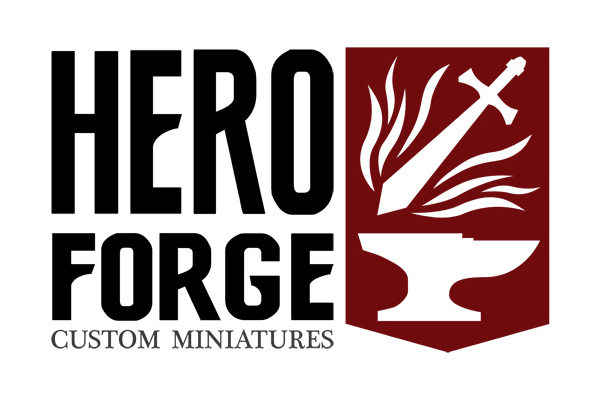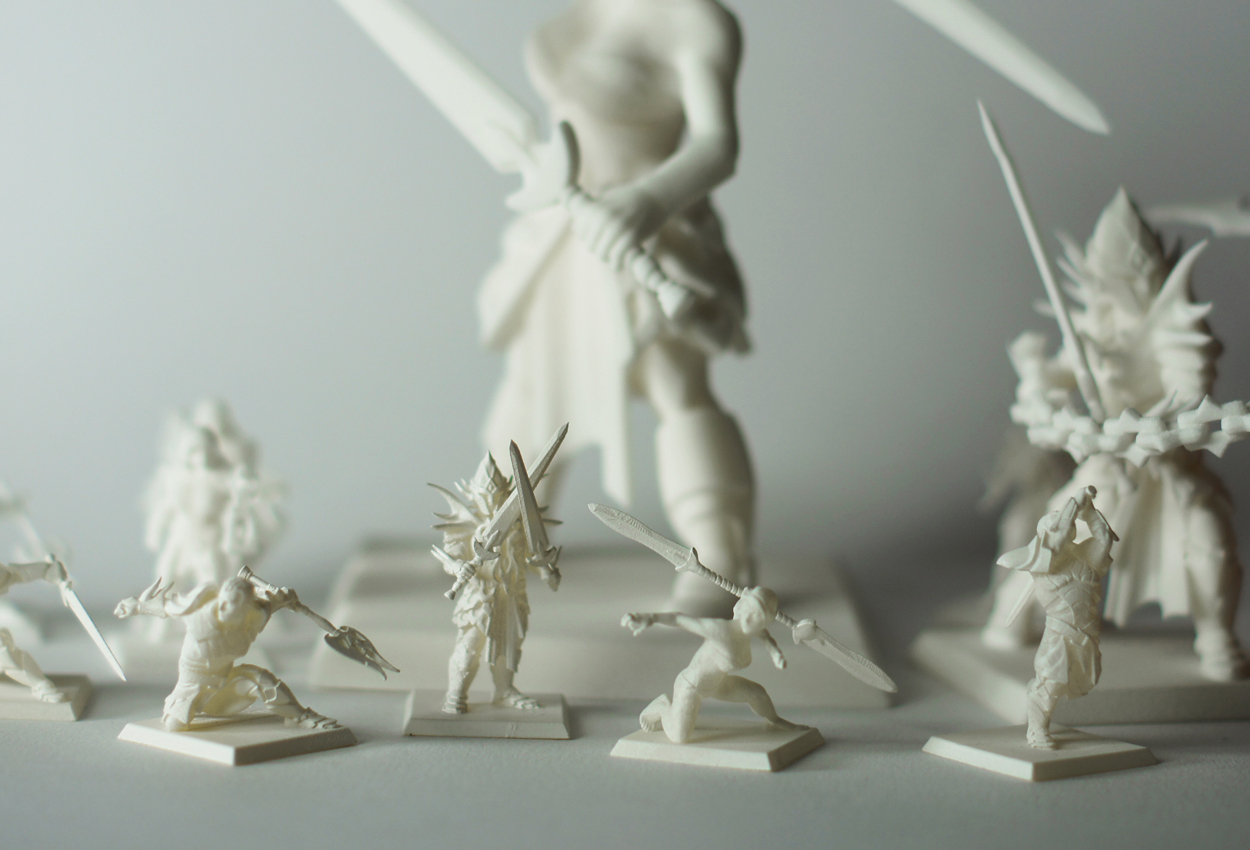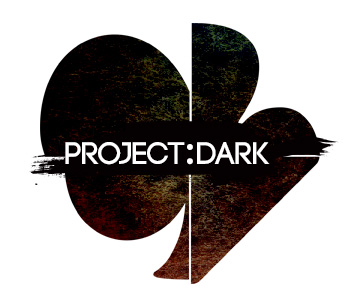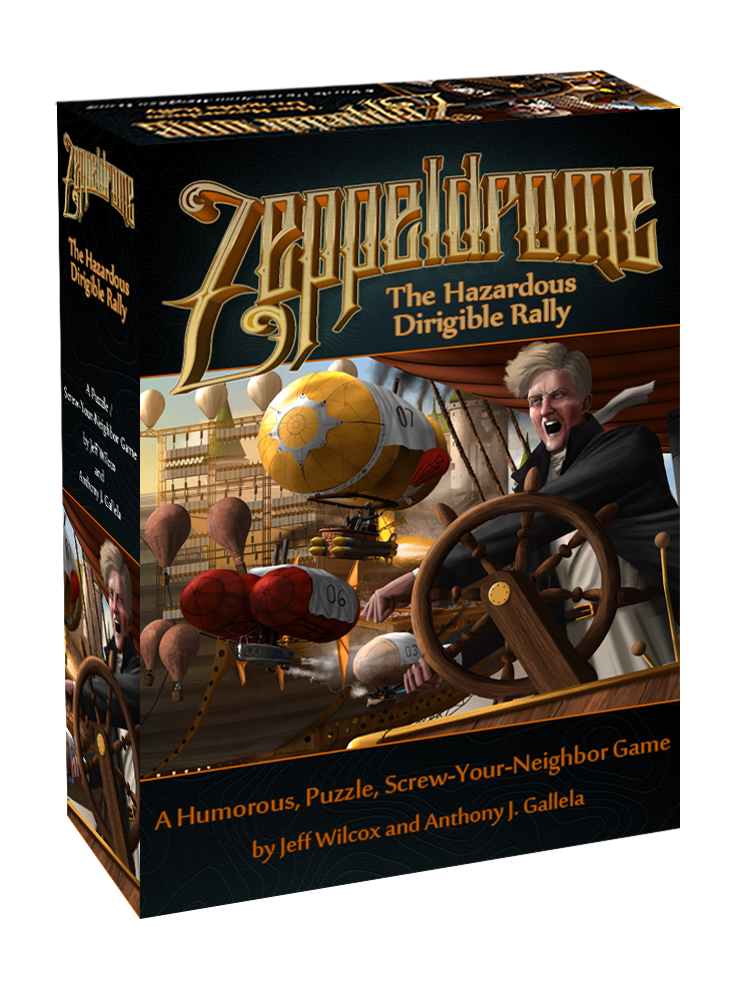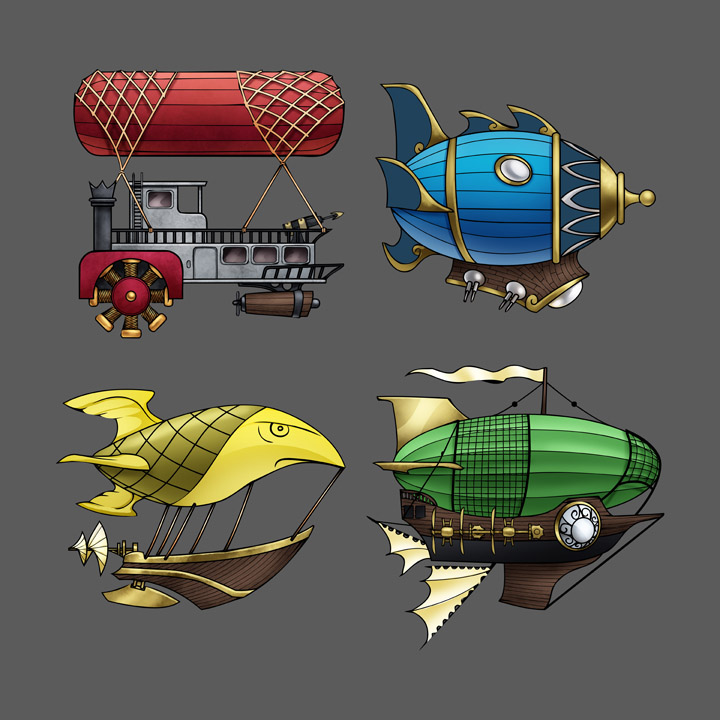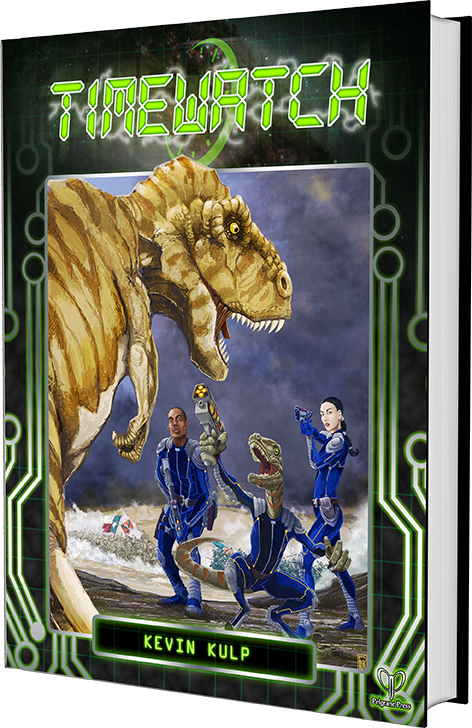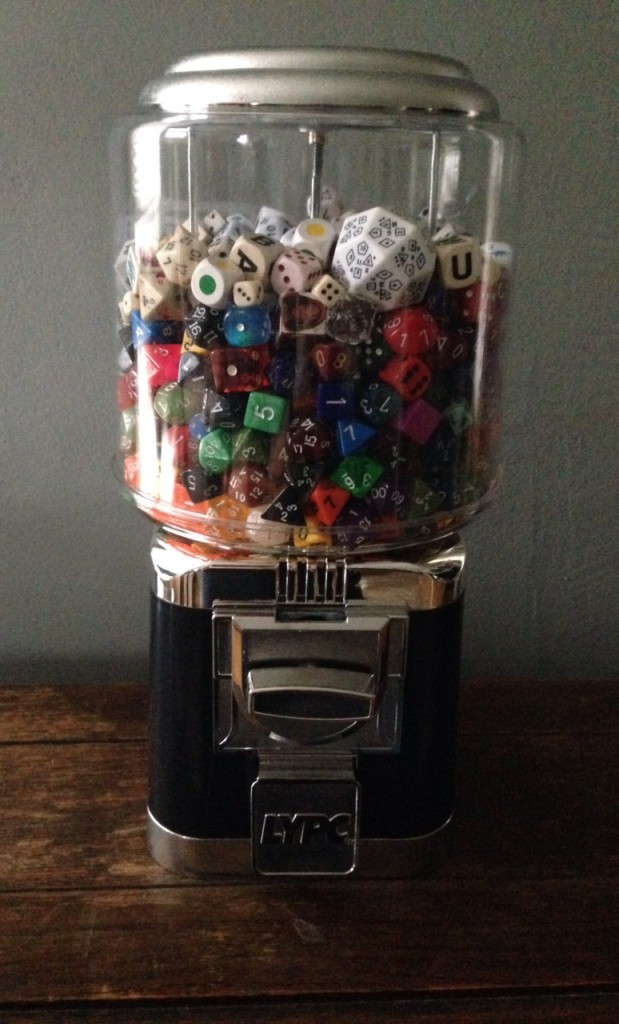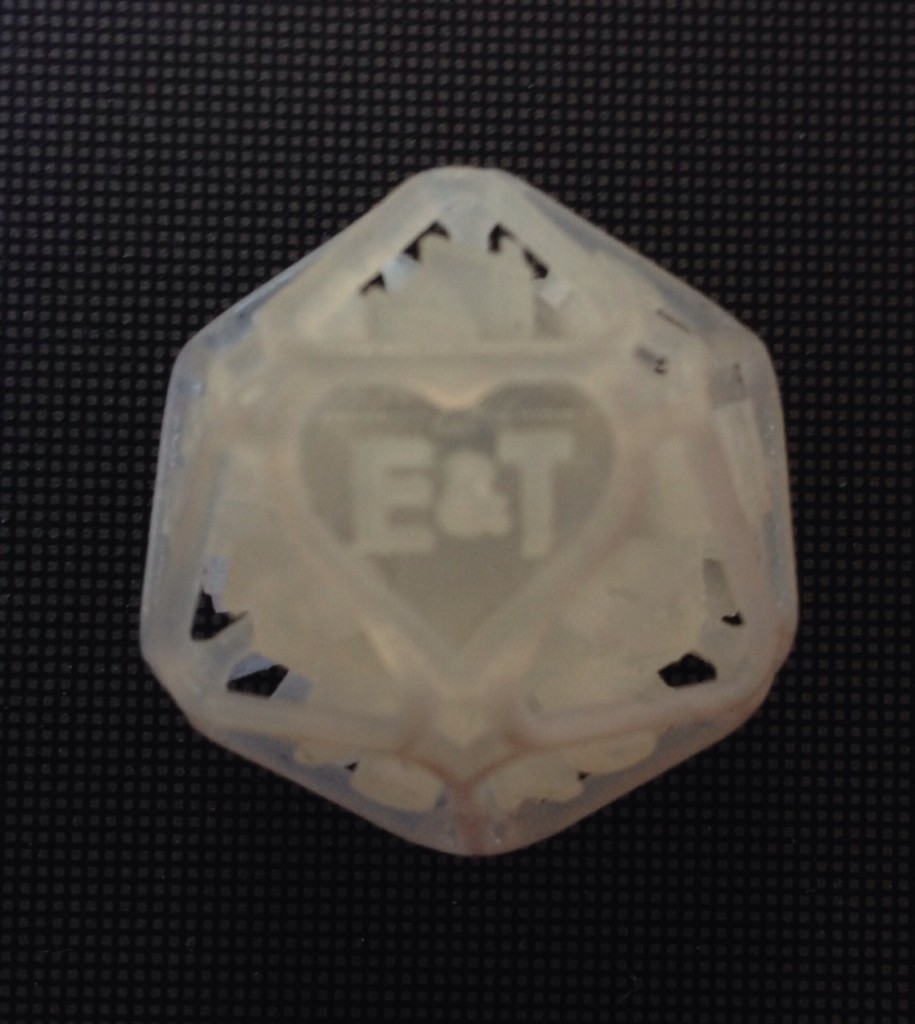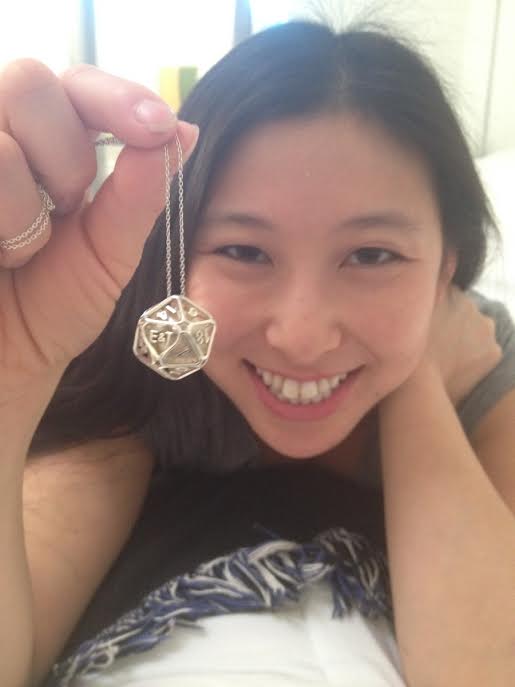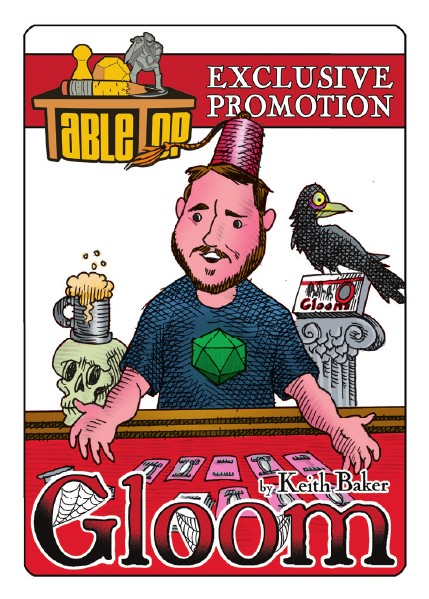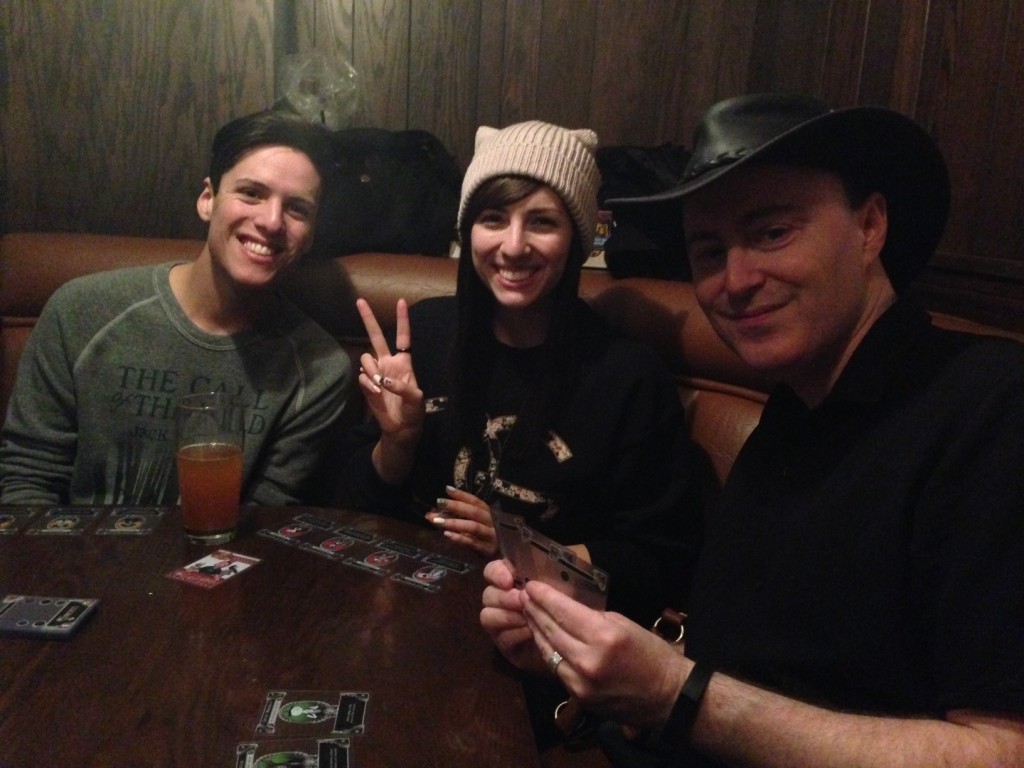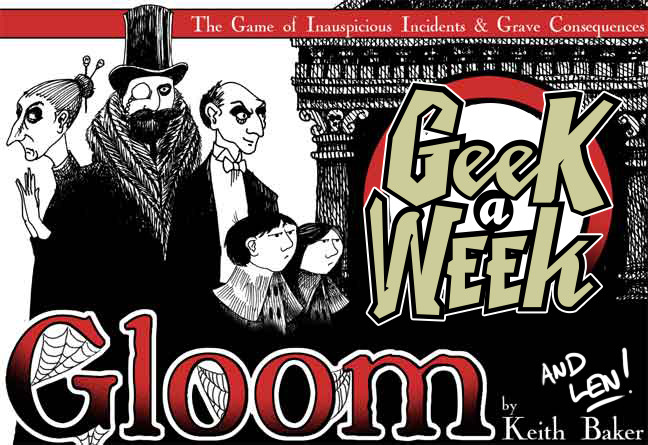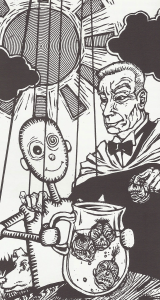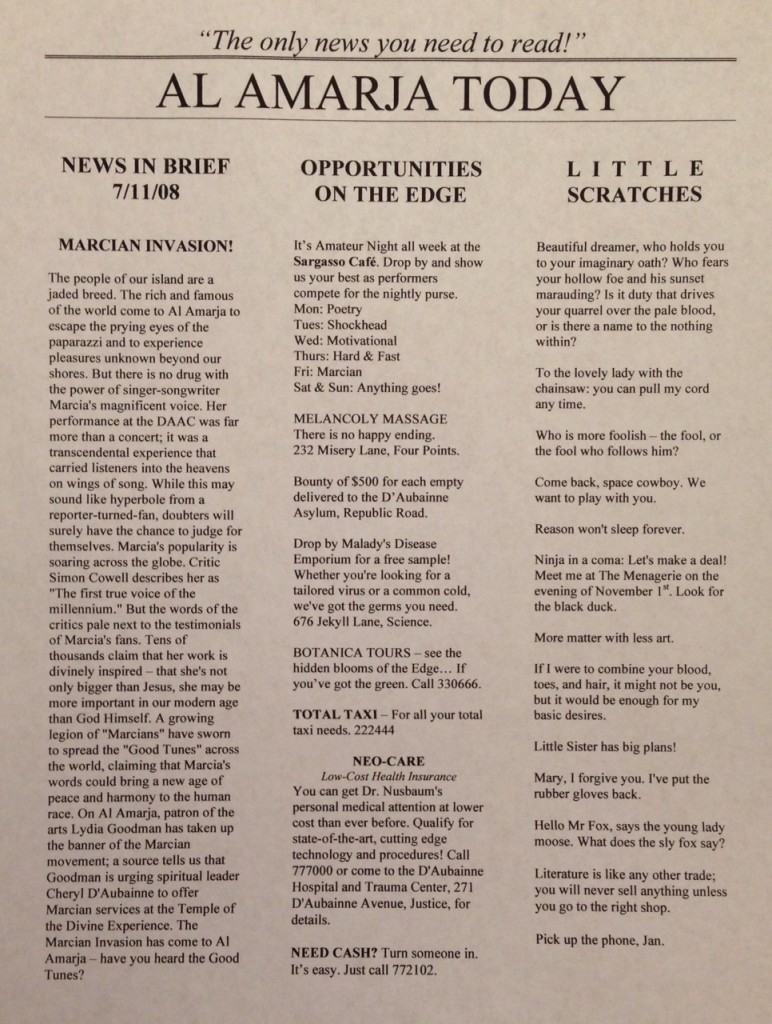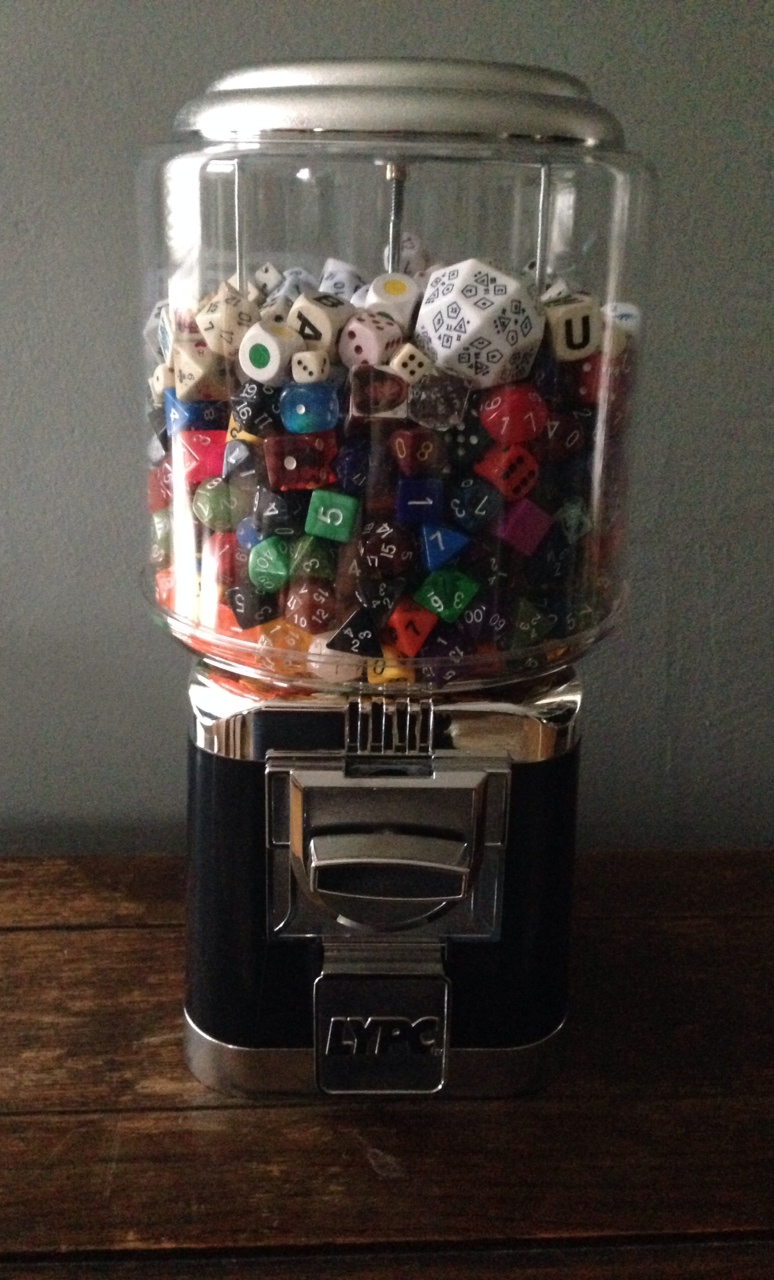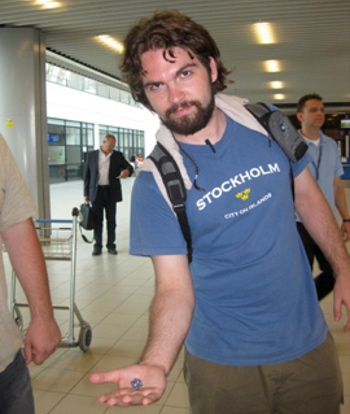The last few months have been very busy. I’ve got many things I’d love to write about, including a bag full of Stories & Dice entries; however, I’m working on multiple deadlines and it’s going to be another week or two before I can get to them.
In other news, I will be attending T.A.B.L.E. in Coppell, Texas on March 28-30th. It’s a gaming expo that’s working to reach out to people who don’t normally play games, and it’s got a few small-time guests like me and Steve Jackson. If you’re in the area, I hope you will come and play a game with me!
And now, the latest round of Eberron questions. As always, my answers are not official in any way and may contradict canon sources; this is how I do things in my personal Eberron.
What’s next for you and Eberron? Anything?
The main news I do have is that the PDF of the 3.5 Eberron Campaign Setting is available online here. As for new Eberron material, no news to report yet, but I’ll let you know as soon as there is anything to know.
Could you tell us about your dndnext Eberron experience?
I don’t have time to go into a lot of detail, I’m afraid. I’m playing a changeling inquisitive (rogue), which means I’m really playing three or four different characters. I’m having fun with my personal vision of changeling culture, in which personas are tangible things that are shared within families and passed down to descendents; so my character has a few identities that are older than he is, and he’s got obligations and expectations to fulfill whenever he uses one of them. After an adventure involving werewolves, the DM and I have actually spun off a whole new take on the history of lycanthropy in Eberron – where the curse originally came from—and this will hopefully play a larger long-term arc in the story of the character. The game itself is sent a few decades in the future of the default setting, which means I don’t know everything; one of the other players is playing Jaela, who mysteriously vanished and has now returned with only a fraction of her former abilities. So far it’s been a lot of fun. The system is very different from both 3.5 and 4E, but there’s a number of things I like about it, and we haven’t had any trouble adapting changelings, shifters, inquisitives, and other elements to the system.
I am trying to make the Orcs more than just Green, Strong Humans and could use some advice.
To me, a key thing is that the orcs are a very primal race. Their emotions and instincts run deep, and they are very passionate. While they are often known for their fierce rages, this passion is just as powerful when in manifests as love or grief. They engage with the world around them more fully than many humans do. It’s easy to look back at their shared history with the Dhakaani and portray the orcs as savages who lived in the woods while the goblins built empires, but the key to me is that the orcs never wanted the civilization the goblins adored. It’s not that orcs are stupid or brutish; it’s that they don’t feel the same need to impose their will on the world that many other races do. They embrace their lives as part of nature instead of holding themselves above it. This is why they have a natural inclination for the primal classes, and why they took so quickly to Vvaraak’s teaching.
As a minor aside, this quote from The Player’s Guide To Eberron might be useful.
Many of the people of the Five Nations are uncomfortable around half-orcs and find the idea of humans and orcs crossbreeding to be vile and distasteful. Such beliefs have never found root in the Shadow Marches, though, and those orcs who chose to welcome humanity to their land were quick to mate with the newcomers. Those who followed the druidic paths knew that hybrids are often the strongest plants, while the Khyber cultists have always seen change as a path to power. In the Marches, half-orcs are celebrated; they are called jhorgun’taal, “children of two bloods.” Blood is everything to the clans, and the jhorgun’taal are the proof that orc and human are kin. They have the strong spirituality of their orc forebears and the wisdom of humanity, and as such many of the greatest druids and priests are half-orcs.
The jhorgun’taal perform important tasks in the Marches, for while they are not as clever or charming as their human kin, they have the trust of both races. As a result, the sheriff of a muck-mining town is more likely to be a half-orc than a member of either of the pure races. Likewise, when the clans send ambassadors to negotiate feuds or trading rights, they often send a jhorgun’taal, even if a more charismatic human comes along as an advisor.
While half-orcs are a true-breeding race in their own right, the jhorgun’taal are just as likely to mate with humans or orcs as with their own kind. The half-orcs of the Shadow Marches don’t see themselves as a separate race; rather, they consider themselves to be the bridge that makes humans and orcs one race.
Looking to the race as a whole, I see orcs as a fundamentally chaotic race where goblins are fundamentally lawful. Goblins thrive on structure and hierarchy; orcs are more driven by instinct and impulse. Where the goblins established a vast empire, the orcs remained bound to family and clan; we’ve never mentioned a “King of the Orcs”. They are passionate and creative, but more driven by what an individual can accomplish than a nation. This doesn’t prevent them from placing value on tradition, as shown by both the Gatekeepers and Cults of the Dragons Below… but even there, both of these faiths are far less structured than the Church of the Silver Flame. Humanity has a greater impulse towards order, and House Tharashk reflects the marriage of human and orc; it benefits from orcish passion and strength, but also from the human desire to build and expand.
This is a simplistic look at a complex race. The Ghaash’kala orcs of the Demon Wastes are highly disciplined… but even there, their structure is less hierarchical and complex than that of the Church of the Silver Flame. Again, my feeling is that on a very primal level they value personal instinct and emotion more highly than the rule of law. An orc lives in the moment and follows his feelings.
While House Tharashk strongly reflects the influence of humanity and the half-orcs, it is worth noting that Tharashk is a house that has already been pushing rules and stepping on toes. Through its dealings with Droaam it is overlapping with the existing business of Orien and Deneith, while its inquisitive business fills a role long monopolized by Medani. This ties to that early point. They are more chaotic and more inclined to pursue their own desires than to accept the established order and be content with one niche.
As a final thought: When the Daelkyr invaded, they made things from the creatures they fought. They made dolgrims, dolgaunts, and dolgarrs from the goblin races. They made chokers out of Halflings. But we’ve never said what they made out of orcs. Perhaps this is because they COULDN’T physically corrupt the orcs, and that this is another reason that Vvaarak chose them; there is something fundamentally primal about the orcs that prevents the daelkyr fleshwarping. Thus instead they chose to mentally corrupt the orcs, preying on their passions and planting the seeds of madness and the Cults of the Dragon Below. If you like this idea, here’s a few other things you could play with…
- We have half-orcs and we have half-elves. We’ve never mentioned, say, half-dwarves, half-halflings, half-gnomes, or half-goblins. This could be because orcs are an exceptionally fertile and versatile race due to their deep primal nature. Note that when we say “half-orc” we don’t say what the other half is… so perhaps you can have orc/goblins, orc/dwarves, etc and it’s just that the orcish half is dominant enough that most people can’t tell them apart. As for elves, the elves are themselves a genetically altered slave race; they too may have an unnatural ability to interbreed with other species (and if you read the Khoravar Dragonshard, the fact that they could produce offspring with humans was a surprise to the elves as well).
- Perhaps the orcs are actually the root race that produced the shifters. The first shifters could easily have been primal champions created by Vvaarak and the first Gatekeepers… orcs blended with animalistic spirits.
Why don’t we see many Cults of the Dragon Above? Apart from draconic prophets, Siberys doesn’t seem to have worshipers.
Well, if you look to the Progenitor myth, Siberys is DEAD; those are the pieces of his body floating in the night sky. People may revere Eberron as the source of natural life and Khyber as the Mother of Monsters, but Siberys died before the world was even created. He gave us gifts; many say that the energy that is the foundation of all magic is the “blood of Siberys.” But Siberys is dead and not looking for your prayers.
Beyond that, very few people worship ANY of the Progenitors directly. The short form is that the Progenitors aren’t seen as active forces. People worship the Sovereigns instead of Eberron, because the Sovereigns are seen as active forces who may intervene in mortal affairs. Khyber won’t and can’t personally do anything to you. But Khyber’s children – the Overlords – can and will. Thus, the “Cults of the Dragon Below” are typically tied to the Daelkyr, to a particular Overlord, or they are crazies who don’t actually think of themselves AS a cult; take a look at this Dragonmark for more details.
Where is your favorite location in Eberron to set a game, and why? Besides Sharn.
Personally? Graywall in Droaam. It’s like Casablanca, only with more trolls. It’s a frontier nation where the law is more or less whatever Xorchylic wants to be. It’s a haven for war criminals, dissidents, bounty hunters, and other interesting characters. There’s ancient ruins dating back to Dhakaan and the Daelkyr below it. And it’s a great opportunity to explore the intriguing possibilities of a nation of monsters. Check out The Queen of Stone for more of my vision of Droaam.
A player wants to play an incorruptible Sharn Watch Captain. How much could he clean up his district before Boromar kills him?
There’s many different layers to this question.
First of all: How is this going to impact your game? If it’s PURELY background… if he’s playing a paladin and wants to say “I started out cleaning up the mean streets of Sharn, and now I’m heading out into the wider world”… personally, I’d let him. If you’re not IN Sharn, what’s the harm in it? It means when he goes back to Sharn, he’ll have some allies and enemies, and he may be disappointed at how things have gone to crap in his absence. But if your adventures aren’t ABOUT cleaning up Sharn, then what’s the harm in him having done some impressive things in his time on the force and somehow kept ahead of the hit men?
On the other hand, perhaps your campaign is about Sharn, and what this player is saying is that he wants clean up the streets as part of the campaign. First of all, what district is he dealing with? Many parts of Sharn already are quite clean; Skyway is a very different place from Callestan. Second, there’s a limit to what one guard can do when the structure around him is corrupt; however gifted and virtuous he is, if his targets keep getting tipoffs, if his companions let them escape, if charges don’t stick, it doesn’t matter how many he brings in. So he may need to clean up the WATCH before he can really make a dent in the Boromar Clan; and once he’s cleaned up the Watch, he’s not a lone target any more. And remember, being in the Watch doesn’t make him judge, jury, and executioner; if he runs around slaughtering Boromar fences and smugglers, HE’S the criminal.
Next up: look at any good noir story. How often do the bad guys just shoot the good guy in the head? It shouldn’t be as simple as “He arrests some guys so they kill him.” Instead, you want to draw it out, and put him in a position where he has to think about his actions and the price of his principles. If this were MY game, I would sit down with the player and ask a number of questions. I’d ask him to tell me his three favorite places in the district he protects. What’s his favorite bar? Or shop? Then tell me his three favorite people. The barmaid? The orphan beggar boy? I’d like to know about his family; his vision of what he wants the district to be; and the worst mistake he ever made (because if this is a noir character, he’s made AT LEAST one). Once I know all these things, I have a wealth of tools to play with that are far more interesting that just killing him. After all, the Boromars aren’t an especially violent organization; they prefer blackmail and coercion to murder. What does he do if they threaten his family? If they take that beggar boy hostage? If they threaten reprisals, and when he ignores the threat, they burn down that bar? If the only tool you have to work with is the life or death of the player, it’s all or nothing. So you need the player to care about other things in the world, so you can threaten those… and follow through on some of those threats. A final challenge here is to come up with a reason the Boromars don’t WANT to kill him. Perhaps he’s so beloved that they don’t want the attention that would come from an assassination… in which case one thing they’ll do is to try and attack his reputation. Perhaps Saiden Boromar has a personal vendetta… the classic “I will take everything away from him before I give him the mercy of death.” Perhaps his family has a connection to the Boromars he doesn’t know about; his father was a corrupt cop who saved Saiden Boromar’s life three times, and Saiden is going to ignore three mortal insults before he takes action.
Side note: personally, I’d be inclined to have the PC be a relative newcomer in the district he wants to clean up. Either he’s just been transferred from a nicer district, or this is where he grew up but he’s been away. Rather than explain how he’s been a pain in Boromar’s rear for years and has never dealt with the consequences, start the clock NOW.
You could turn it around and say that it simply makes no sense that the PC has survived this long… but someone else is looking out for him. Someone shoves the assassin from his hiding place so the PC has a chance to defend himself. Someone pushes the poisoned drink from his hand. Someone gets the barmaid out of the bar before it’s destroyed. Is it the Chamber? A Lord of Dust who has plans for the PC? The Tyrants? House Thuranni? Someone could have long term plans for the PC… or they could want to see the PC clean up the district, but want him to be the figurehead.
The short form: There’s lots of ways to make this background work. It’s all a question of how far you want to go with it, and what impact it’s really going to have on your actual campaign. As a minor recommendation, I suggest Warren Ellis’ Fell (available in graphic novel form); here you have a story of a remarkable detective sent into a corrupt place, who does his best to clean it up but is limited by the overwhelming scope of the corruption and his own very limited resources. Find ways to make little things feel like big victories; he doesn’t have to bring down the entire Boromar Clan on day one, and they can overlook a lot of little losses.
How do you keep track of SO many factions?
Generally speaking, I don’t. In any particular campaign, I pick a certain number of factions I want to use, and I pick a few of the major villains. I don’t try to weave Vol, the Dreaming Dark, the Daelkyr, the Aurum, the Lord of Blades and half a dozen Overlords into a single coherent plot; instead I pick two or three that I will focus on, typically with one as the obvious initial threat, one as the hidden long-term threat, and one as the wild card, and focus on those. The others are around for me to sprinkle in for interesting one-shots, but I don’t try to make them all equal. Short form: Most of these forces are playing a waiting game. The Stars (or the Prophecy) need to be right for the Daelkyr to pose a threat. If I don’t want to use them, I simply assert that their stars won’t be right for another century; they simply aren’t going to be major players in this arc. This also addresses the question of why all these world-threatening forces aren’t stomping on each others’ toes; they simply don’t all have to be active right at this moment.
Are there many other large ‘franchises’ in Eberron, aside from the Houses?
Certainly. Most of the major members of the Aurum are people with their own franchises of one form or another; I suggest you check out this Eye on Eberron, if you can. Organized crime gives you another recognized brand, such as Daask and the Boromar Clan. Many of these sorts of franchises are limited to a particular nation, but are still everyday encounters in those nations. On a broader scale, you have the Church of the Silver Flame, which touches the world in many ways; a key example would be their free clinics. You generally can’t get the magical services you could get at a Jorasco house and it’s not as comfortable, but it’s a low-cost alternative for people who need help and something everyone is familiar with. Another would be the Korranberg Chronicle, which is known and respected across Khorvaire.
Drow – Why scorpions?
It’s a common misconception (one made by many of the inhabitants of Khorvaire and Stormreach) that the drow are especially hung up on scorpions. The Sulatar and Umbragen don’t care about scorpions at all. Among the jungle tribes, Vulkoor the Scorpion is simply one of a pantheon of primal spirits; if you read The Gates of Night or The Shattered Land, Xu’sasar calls on a number of other spirits. The Vulkoori tribes consider Vulkoor to be the greatest and most powerful of these spirits, but that’s a particular choice of a particular group of tribes.
WHY do souls go to Dolurrh? Did they originate there and are returning home? Is there some sort of magic pulling people there? Where did it originate? Why are souls made? (Are these “Big Unanswerables”?)
These are Big Unanswerables. A key point is that no one actually agrees on what Dolurrh IS or what happens to the souls that go there. It’s a provable fact that when someone dies a soul appears in Dolurrh that matches them, and that this soul then fades over time. The most common theory among the Sovereign Host is that the “fading” isn’t destruction at all; rather, Dolurrh is a GATEWAY to the realm of the Sovereigns, a place that is beyond all mortal experience and cannot be visited even with planar magic. The “fading” effect is the process of the soul transitioning to this higher realm; and what is left behind is just a husk, like a discarded snakeskin. Meanwhile, the Blood of Vol asserts that Dolurrh is the end; some believe that the Sovereigns created Dolurrh specifically to destroy mortal spirits, and that your spirit is drawn their after death because they designed it that way. Others say that the “fading” is the spirit being cleansed so it can be reused and reincarnated. But there’s no absolute “right” answer.
With that said… the general answer to big unanswerables such as “Why are souls made and what draws them to Dolurrh” is “The Progenitors did it.” The Progenitor myth includes the creation of the planes and the creation of mortal and immortal life. They set the system in place; they simply don’t interfere with it directly now it’s in motion. Meanwhile, the Sovereigns aren’t described as having CREATED the world; they simply govern particular aspects of it.
In your opinion, which nation is most likely to restart the Last War?
In MY Eberron, definitely Aundair. Of the current rulers of the Five Nations, Aurala is the only one who’s called out as really having a strong vision of reuniting Galifar. In my Eberron, Aundair is also aggressively pursuing research into new forms of war magic, as arcane magic is the only thing that offsets Aundair’s small size and population. This could be seen as a threat or provocation by the other nations… or alternately, if Aundair does develop superior rituals it could give them the confidence to act.
Another possibility is Cyre. Groups such as Dannel’s Wrath want vengeance for the fall of Cyre, and might engage in terrorist actions designed to provoke the other nations to war.
None of the other rulers—Boranel, Jaela, or Kaius—are portrayed as having an interest in war. However, Boranel and Kaius are specifically called out as being in precarious positions. Boranel is old and there’s a movement that’s interested in unseating the monarchy in Breland; and Kaius has alienated many of the warlords. If a current ruler is displaced, a new ruler could emerge with a more aggressive agenda.
The comic introducing Chapter 1 of Magic of Eberron suggests that nobility can have Karrnathi undead minions. Is that common?
It depends how you define “minions.” You can’t buy Karrnathi undead, and you can’t key them to be specifically loyal to a particular person. For more information on the process used to create them and the nature of Karrnathi undead, check out the article on Fort Bones.
Karrnathi undead are soldiers by nature. It’s believed that they channel the martial spirit of Karrnath. As such, they typically abide by the military chain of command; in The Queen of Stone, there’s a Karrnathi skeleton with the Karrnathi delegation. You could also find them serving bone knights regardless of their current standing. So personally, when I look at the comic in Magic of Eberron, I assume that Lord ir’Krast is a bone knight or a high-ranking member of the Emerald Skull or a similar order. The skeleton is loyal to someone who happens to be a noble; that doesn’t mean any random noble could purchase a Karrnathi skeleton. It’s one of the economic advantages of the warforged; anyone could buy one of those.
How would one get to the Lair of the Keeper in the Demon Wastes?
The simplest way would be to take a boat to the ruins of Desolate and cut across on land from there. A more difficult path would be to go through the Labyrinth to Festering Holt and go north, which among other things takes you very close to Ashtakala. Bear in mind that there’s no perfect maps of the Demon Wastes, so it’s not as though anyone in the Five Nations knows EXACTLY where the Lair of the Keeper is (and SURPRISE – it’s shielded from divination!). It’s very much a “Here there be dragons” situation; its location is loosely derived from a handful of ancient accounts and Ghaash’kala myths. If you really want to find it, you’d be best off getting a local guide or dealing with a living person who’s been there… say, Sora Teraza.
What info have you been hiding about the dwarves that got sealed in Khyber by their now topside dwelling kin?
I feel like I’ve written about this in detail somewhere, but I don’t remember where. Short form: In MY Eberron, they were wiped out or corrupted beyond recognition during the Daelkyr Incursion. The ruins of the Old Kingdom are now filled with aberrations and other horrors, and there’s a Daelkyr somewhere beneath the Ironroot Mountains. Mror heroes sometimes go below in search of glory and treasure.
Oh, and bear in mind, the surface dwarves didn’t seal the other dwarves below… the surface dwarves got KICKED OUT of the awesome subterranean kingdom. Check out this Dragonshard on the subject.
Which factions or countries have the largest rivalries with each other?
There’s no shortage of rivalries…
Karrnath and Thrane
The Chamber and the Lords of Dust
The Royal Eyes of Aundair and the King’s Citadel of Breland
The Kalashtar and the Dreaming Dark
Adar and Riedra
The Blood of Vol and the Sovereign Host
Thuranni and Phiarlan
Cannith and Cannith (and Cannith)
The Aurum and the Twelve
House Tarkanan and the Twelve
Aundair and the Eldeen Reaches
The Ashbound and House Vadalis
The Gatekeepers and (some of) the Cults of the Dragon Below
The Boromar Clan and Daask
The Lhazaar Princes and the Lhazaar Princes
Erandis Vol and the Undying Court
The Swords of Liberty and the Brelish Monarchy
… And that’s just the tip of the iceberg. Beyond that, if you pick one of the Five Nations, you can probably find a faction in any of the other Five Nations that hates them.
What is the royal symbol of the kingdom of Galifar?
I’m not sure it’s ever been defined in a canon source. In my Eberron, it’s a gold crown bearing five jewels, set against a green field; I believe a canon source somewhere speaks of Cyre as “the purple jewel in Galifar’s crown,” and this is where that expression comes from. Cyre kept the Crown of Galifar on its flag during the war, while adding other elements.
Are there equivalents to European monastic orders for the major faiths?
Sure. It’s touched on at the beginning of this Dragonshard, though it then turns to a description of more martial orders.
Many of the creatures can trace a path back to their origins, but what of shapechangers? We know changelings descend from dopplegangers, but where do beasties like dopplegangers, and by proxy things like tibbits, come from?
Depending on what edition you’re using, the distinction between changelings and doppelgangers can be blurred. In 3.5 they are concretely distinct species; in 4E “doppelganger” is an alternate word for changeling, implying that the changeling uses his abilities for larcenous purposes. As for origins, I’ve developed a particular changeling creation myth for my D&D Next character; perhaps I’ll include it in a dedicated Changeling post in the future. I’ll also point out that one of the first D20 products I had published was The Complete Guide to Doppelgangers, by Goodman Games; there I propose a lifecycle that links doppelgangers and mimics, though it’s not something I’d use for changelings as presented in canon Eberron.
Who judges those convicted to go to Dreadhold? Sivis judges, international judges, judges from the 5 nations?
The key thing to bear in mind is that Dreadhold isn’t directly tied to ANYONE’S legal system. Dreadhold is a for-profit operation run by a business, House Kundarak. Consider prisoner Deep Fourteen, who some believe to be the true Kaius III. He was never convicted of any crime. Almost no one in the world knows that he exists. He was sent to Dreadhold by the King of Karrnath, who is paying for his incarceration. With that said, does this mean ANYONE can send someone to Dreadhold? Probably not. I expect that Kundarak has a certain criteria they apply before they accept prisoners from you, likely defined by your legal status and your wealth. The short form is that they take prisoners sent to them by the courts of the Five Nations… but they probably also take prisoners sent to them by the Aurum or patriarchs of Dragonmarked Houses. It’s not Kundarak’s job to determine guilt or innocence; it’s their job to imprison the people they are paid to imprison, for as long as they are paid to do so. A potentially interesting point would be to have Dreadhold release a host of dangerous criminals or political dissidents (some who may have been preserved in the Stone Ward for centuries) that were imprisoned by United Galifar or Cyre, because none of the Thronehold nations want to keep paying for their imprisonment.
Being a private or for-profit endeavor, house Kundarak could get in trouble in my opinion if they accept to imprison someone in exchange for payment when that someone is innocent or not deserving such a harsh punishment and is sent to Dreadhold by a nation or anyone else who is its rival.
First off: We HAVE discussed the existence of international courts that judge war crimes, established under the terms of the Treaty of Thronehold. The key is that these courts have nothing in particular to do with Dreadhold. They can choose to send a person to Dreadhold, but if they do someone will have to be designated to pay for it, and be treated like any other client. Kundarak evaluates every prisoner submitted to Dreadhold. They consider all the risks associated with incarceration; these include the challenges posed by the prisoner and risks associated with the prisoner’s outside influence. If they decide to accept the prisoner, they set the cost of imprisonment. If the client agrees to those terms, they will maintain the incarceration until the client or their heirs cease payment or cancel the contract.
What DON’T they consider? If the prisoner is innocent or guilty. That’s not their problem. Dreadhold isn’t about justice. Every nation has its own prisons. Dreadhold isn’t part of any nations’ judicial system. You send someone to Dreadhold when no other prison can hold them; when you are concerned about an uprising or military action to free them; or when you can’t kill them but never want them to see the light of day again, like Melysse Miron. Dreadhold exists in international waters, and it’s not under the jurisdiction of any kingdom. If Aundair objects to the imprisonment of someone Breland has sent to Dreadhold, Kundarak’s answer is simple: take it up with Breland. If you want, you can lay siege to Dreadhold; however, it is one of the most impregnable fortresses in Eberron and on top of that, your nation would face immediate sanctions from the Twelve.
This touches on one of the key themes of Eberron: the balance of power between the houses and Eberron. When Galifar was united, Kundarak would be unlikely to refuse the King of Galifar if he demanded the release of a prisoner. But the Queen of Aundair is an entirely different matter… and it can be argued that Aundair needs the Twelve far more than they need her. Is she willing to risk losing the services of all the houses at a time when she’s contemplating war? Essentially, no single house HAS the leverage to place demands on Kundarak… and thus, Kundarak will simply say “Take it up with the people who sent the prisoner to us.”
Case in point: Prisoner Deep Fourteen. He’s being held incommunicado, masked, in a deep cell. His identity is hidden from the world. Is he guilty of something? Given that we don’t even know his identity, who knows? Kaius wanted this person to disappear forever, so he sent him to Dreadhold… there’s no one to challenge this, and Kundarak doesn’t care what his story is.
With that said: Kundarak can and will refuse submissions. Let’s say Erandis Vol kidnapped Jaela and sent her to Dreadhold. Kundarak would in all likelihood refuse to take her, not wanting to have the entire Church of the Silver Flame rise against them. On the other hand, if Cardinal Krozen sent her to Dreadhold with the full support of the church, they would take her. It’s not a question of innocence or guilt; it’s the fact that if she’s sent by the church, it’s safer for Kundarak to take her.
But the key thing to remember: Dreadhold isn’t about justice. It’s a business, plain and simple. Half the people in there may be innocent; if you want to get them out, take it up with the people who imprisoned them, or break them out yourself.
Is the Church of the Silver Flame still paying for Melysse Miron’s incarceration, or do they have an alternate deal worked out with Kundarak?
Yes, they are still paying for her. With that said, I doubt she’s the only one; I suspect they have a significant ongoing payment that covers a significant number of prisoners. It’s likely they are covering Saeria Lantol’s imprisonment as well. The mandate of the church is to protect the innocent from supernatural evil. If the best way to do that is to pay for its incarceration, they will.
How do the Sentinel Marshals view Dreadhold? On the one hand, it houses legitimate prisoners, which they must support, but does the incarceration of others not in accordance with any law give them pause? If a person was kidnapped according to the laws of the nation in which the crime occurred, and then sent to Dreadhold, would the Marshals feel a need to do anything about it?
A key point: The Sentinel Marshals aren’t some sort of Justice League, fighting crime for the good of all. Let’s take a look at the first source to describe the Sentinel Marshals, Sharn: City of Towers:
During the reign of King Galifar III, House Deneith was granted the right to enforce the laws of the kingdom, bringing fugitives to justice and enforcing punishments in exchange for gold.
Sentinel Marshals aren’t tied to the Watch. They aren’t casual law enforcers. If a Sentinel Marshal is walking down the street and sees a robbery, he’s not OBLIGATED to do anything about it. Many are honorable people who MIGHT… but that’s not their job. They are private contractors who are authorized to enforce the law across Khorvaire. Some Sentinel Marshals are deeply concerned with honor and justice; for others it’s just a job. It’s a job they have to take very seriously – Sentinel Marshals are held to very high standards of conduct – but you could easily have an evil Sentinel Marshal, who plays strictly by the rules but doesn’t give a damn what happens to the criminals he brings in. Meanwhile, looking back to Kundarak: THEY aren’t the kidnappers. As I said, Dreadhold is in international waters. If the person who brought the prisoner to Dreadhold kidnapped them, fine – FIND THE KIDNAPPER and get them to end the incarceration contract. So say Saiden Boromar kidnaps someone and sends them to Dreadhold. If there’s a Sentinel Marshal who’s so infuriated by this miscarriage of justice that he’s going to take independent action to do something about it, the best thing for him to do would be to expose Saiden and bring him to justice. SAIDEN has committed the crime of kidnapping in a nation bound by the Code of Galifar. Dreadhold is NOT bound by the Code of Galifar.
Fun side note: As Dreadhold is in international waters and not actually covered by the Code of Galifar, it’s technically not a crime to break into Dreadhold. It’s a frontier operation. if Kundarak catches you, well, they may just throw you in a deep cell… but you won’t end up in a court anywhere.
Again about Dreadhold, since they are in international waters, they could be payed to perform tortures to a prisioner?
I’m sure that they could; after all, one could argue that the conditions of Deep 14’s imprisonment are a form of torture. With that said, I don’t see them resorting to torture to acquire information. In a world where people have access to detect thoughts, zone of truth, discern lies, and so on, I can’t imagine that the keepers of the most sophisticated prison in Eberron would use physical torture as a primary means of extracting information… though I suppose that physical and psychological torture could be COMBINED with some of those spells as a way to force an answer and then verify its accuracy. While they could farm this out to another house, it wouldn’t surprise me if Kundarak has its own specialists in this; after all, psychological warfare would play an important role in holding certain prisoners.
Since he came up, are there any people that you have in mind for Prisoner Deep Fourteen besides the real Kaius?
Spoilers here, so if you don’t know Kaius’ story skip this question. I don’t have anyone in mind for D14, but I could brainstorm a few possibilities, given a moment. He’s someone Kaius wants alive, but not allowed to speak or write. The idea that he’s a relative is one possibility. Another is that he’s a Karrnathi warmage who committed war crimes so vile he couldn’t be left at liberty (in part because other nations would demand justice) but Kaius wants to be able to retrieve him if there’s another war. A third even zanier possibility is that HE is Kaius I, and that the biggest secret of Karrnath is that Kaius III IS Kaius III, presenting himself to Kaius’ inner circle as his grandfather. If you want to get really deep into conspiracies, try this. Erandis arranged to have Kaius transformed. Because of the nature of this process, the vampire that transformed Kaius has direct influence over him, if s/he chooses to exert it. Unwilling to live with this threat hanging over him, Kaius I turned Kaius III into a vampire. In this theory, I’m asserting that a vampire can assert control over his direct progeny, but not over THEIR progeny. So K1 sires K3, and then arranges for K3 to send him under deep cover into Dreadhold. K3 poses as K1 posing as K3. His mission: to find and eliminate K1’s sire, so no one can dominate K1; once that’s done, he’ll free K1 from Dreadhold. In the meantime, Erandis is baffled by the fact that she can’t exert control over Kaius.
Personally, I like the idea of K3 posing as K1 posing as K3… but perhaps I’ve been watching too much Orphan Black.
Now, I just came up with this idea on the spur of the moment. But running with it a little further, you can get even farther out there and say Kaius III isn’t a vampire. Here’s the sequence of events. Kaius is turned into a vampire by Erandis. After being undercover for a time, Erandis sends him to replace K3 and take over Karrnath; she likes the idea of having a puppet on the throne. But K1 is no one’s puppet, and he has his own scheme. K3’s lover Etrigani is a deep-cover Deathguard agent, and knows rituals that can allow a living person to appear undead, a variant of the half-life techniques common among the Jhaelian clan. Together, Etrigani, K1, and K3 arrange to make it SEEM as though K3 is actually vampire K1. This “coup” – the idea that K1 has replaced K3 – is revealed to Morana and the other inner circle of Karrnath, and of course all of Vol’s spies. “K3” – actually K1 – is sent to Dreadhold, and made incommunicado, so there is no way for Vol to manipulate him; he can’t get out even if he wanted to. Etrigani and K3-posing-as-K1 want to destroy the vampire that sired K1 and to get as much information as they can about Erandis’ inner circle and her reach in Karrnath. Again, in this scenario Etrigani is an agent of the Deathguard, who have been trying to eliminate Erandis for centuries. But K1 is under close scrutiny by Vol. She doesn’t understand why she can’t control him, but he’s doing his best NOT to reveal his true identity. He’s too closely watched. He needs agents she doesn’t know… agents like the PCs.
The main thing I like about this is that most people who know Eberron know that Kaius III is a vampire and Kaius I. To negate both of these – not only is he actually Kaius III, he’s not even a real vampire – is a great way to catch people who think they know everything about the world offguard. And it helps solidify K3 and Etrigani’s relationship; it’s not that she loves him in spite of his being a vampire, something that’s an anathema to her people; rather, she loves him because they are working together to bring down Erandis, and it’s her skills that allow him to maintain his masquerade.

